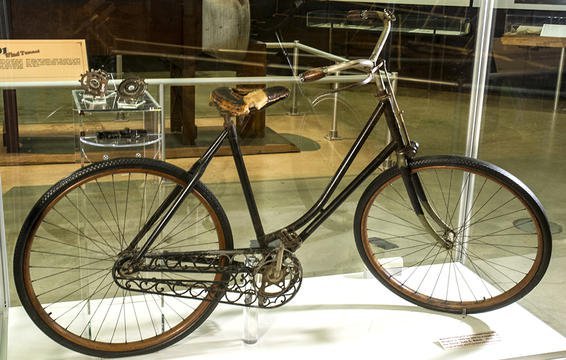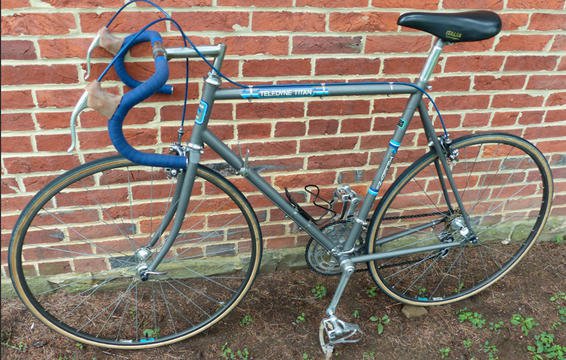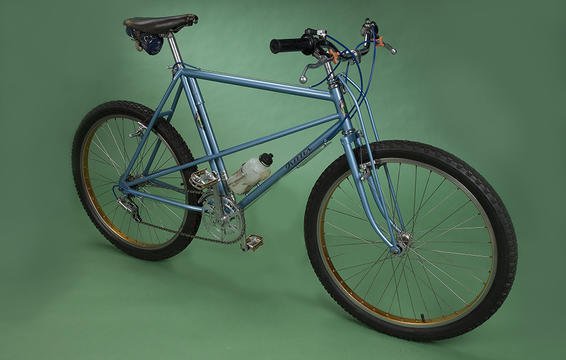25 of the Most Influential Bicycles of All Time
The bicycle is celebrating its 200th birthday this year. From the 1817 Draisienne to today's fat bikes, these are the bikes that have shaped how we ride.
The bicycle is celebrating its 200th birthday this year. From the 1817 Draisienne to today’s fat bikes, these are the bikes that have shaped how we ride. – Katie Fogel and Miranda Smith

It’s hard to imagine a world without bicycles, but our favourite way to get around and raise our heart rate is a relatively recent invention: The bicycle recently celebrated its 200th birthday. The first bike ride took place on June 12, 1817.
When Baron Karl Freiherr von Drais of Germany piloted a curious wooden contraption supported by two wheels, he both introduced the world to the first iteration of the bicycle and set in motion a transportation revolution that is still rocking the world 200 years later.
Drais tested his Laufmaschine (German for ‘running machine’) on a 4.3-kilometre route from Mannheim to a postal service stopover in the city’s Rheinau district, managing an average speed of 15km/h. Covering that distance aboard what amounts to an adult balance bike is in itself a brag-worthy feat, but his successful maiden voyage did more than prove his ability as an inventor. The Laufmaschine (later eponymously labeled the draisine) was allegedly a direct response to the growing cost of keeping horses for transportation. In creating a vehicle that not only covered distances at speeds equal than or greater horse-drawn carriages, and that also didn’t need to be fed, the baron made it possible for more people to travel long distances, more easily.
In celebration of the baron’s gift to the world, we’ve compiled a list of the 25 most influential bikes of the past 200 years.

Baron Karl von Drais’ wheeled alternative to horses was the product of years of tinkering. An alternative to the 1791 French Célérifère personal vehicle, the ‘Laufmaschine’ added a steering mechanism so the rider could better balance and navigate.
Drais’ invention was almost entirely made of wood and lacked pedals, but it allowed him to travel at twice his walking pace with no more effort. Later known as the Draisienne, it was often an object of ridicule, and Drais was never able to get it produced on a factory scale—but the first bike did have its fans locally and abroad. Men from France, England, and the US took out patents based on Drais’ invention, allowing the bicycle to live on and evolve into the bicycles we love today.

Today, bicycles are powered using rear-drive systems, but this wasn’t always the case. In the 1860s in Paris, Pierre Michaux worked to develop the two-wheeled, front-drive velocipede, attaching cranks and pedals to the front wheel to create the first pedal-driven bicycle.
One of Michaux’s allies in producing the velocipede, Pierre Lallement, tried to claim the innovation for himself and ended up taking the bicycle to the US in 1865. Lallement’s velocipede quickly gained popularity in eastern cities, particularly amongst Harvard and Yale students. The craze was short-lived, though, as the velocipede was cumbersome and required great strength and coordination to both steer, pedal, and balance.

An enthusiasm for racing led to innovations for a faster bicycle. In 1870 in Coventry, England, James Starley and William Hillman created the original penny-farthing, the Ariel. The revolutionary use of wire spokes allowed for lighter, larger wheels, making possible the high-wheel bicycle, constructed atop one large front wheel and one smaller rear wheel.
The Penny Farthing—named for two coins that differed in size similarly to the bicycle’s wheels—was able to travel at higher speeds thanks to the large front wheel, but also proved to be dangerous. Its height made it difficult for riders to mount and dismount; the high center of gravity made balance challenging; and the large wheel was vulnerable to roots and stones in the road, shaking the entire bicycle and threatening to catapult the rider forward with each bump.

Before 1878, the US didn’t have a domestic bicycle manufacturing industry. Inspired by imported Ariels— English penny farthings with tangent spokes and steps that made them easier to mount—Colonel Albert Augustus Pope sought to create an all-American high-wheeler and mass-produce it by the thousand.
Pope’s bicycle, the Columbia, was similar in design to European penny farthings, but his monopoly on bicycle patents, move toward mass production, and keen advertising strategy allowed his business to take off.
By 1900, Pope Manufacturing Company had transformed cycling in the US, selling thousands of bicycles a year and inspiring organised racing.

Harry Lawson was a British bicycle designer who developed several types of bikes during the 1870s. He created the first safety bicycle with a chain-driven rear wheel.
Lawson’s bike was not very well received and deemed a commercial failure, but he had invented a key design feature—that eventually led to James Starley’s much more successful Rover—ranking him alongside Starley as an inventor of the modern bicycle.

In an effort to make bicycling accessible to more would-be riders, John Kemp Starley—the same man behind the Ariel penny farthing—created the Rover in 1885 in Coventry, England.
The Rover was the first successful ‘safety bike’: In making use of similarly sized wheels that brought it closer to the ground—as well as a direct-steer fork—the Rover was more efficient and safer than its predecessors. Without the high-wheel, riders were able to sit much lower and more comfortably atop the frame.
To prove that the Rover was not only safer than the high-wheelers but faster, too, Starley organised a Rover race in which a number or riders beat the record time for a 160km ride.


Before the Wright Brothers built their famous airplane, they built bicycles. On April 24, 1896, they introduced the Van Cleave. It was mostly handmade, and came with a special self-oiling hub. They sealed the bearings with felt washers, thus creating an oil reservoir inside the hub. This helped cut down on maintenance.
After the Wrights made their first flight in 1903, they began to stop manufacturing bikes to focus more on aeronautics. They then sold all their remaining bicycle parts and the rights to the Van Cleve name to a bicycle salesman named W.F. Meyers. Meyers continued to sell Van Cleve bicycles until 1939.

In 1903, Henri Desgrange and his colleague Géo Lefèvre organised a long-distance race through France to boost sales for Desgrange’s sports magazine, L’Auto; the 19-day race would be the first ever Tour de France.
The bicycles raced in the first Tour featured steel frames and handlebars, wooden wheel rims and big balloon tyres. They weighed roughly 15kg and offered two gears, but the rider would have to stop and remove the rear wheel to shift. Though all the bikes in the first Tour de France were designed similarly, it was appropriately a French bike that came out on top. All of the first five finishers, including winner Maurice Garin, rode in on La Français Diamant.

Paul de Vivie is credited for designing the first bike with a functional rear derailleur. His invention required the chain to be moved by hand between two chain wheels, giving him four gears. He combined his invention with the proteon gear from the English Whippet, which used a split chain wheel. This allowed the chain two halves of the chain wheel to open when pedaling backwards. Pawls then secured them in one of four positions to give riders four different gears.
In 1906, this development appeared in his Cheminot, the first derailleur. De Vivie did not take out a patent, and hardly made any money from an invention that would change cycling forever.

The Schwinn Paramount was introduced in 1938, and saw phenomenal sales until the start of World War II. By the late 50s, the Paramount became the top bike for US pro racing. The Paramount used high-strength steel alloy tubing and brass, lug-brazed construction. In 1993, Richard Schwinn and Marc Muller purchased the Schwinn Paramount plant and founded Waterford Precision Cycles. The Paramount line was retired in 1994, but reintroduced in 1998, where it sold through 2009.

First sold in 1960, the Schwinn Varsity was the most widely sold derailleur-equipped bike of all time with nearly two million sold. The 21-inch aluminium suspension frame with a rigid fork has been jokingly called “the heaviest lightweight bicycle ever built.”
In terms of design, the Varsity looked like many European imports, but its low cost led to a high popularity. This also made the sport of cycling more accessible to Americans. The bike’s signature derailleur even popularised the term “ten-speed.” The Varsity was retired in 1960, but remains an American classic.

British industrial engineer Benjamin Bowden designed a futuristic bicycle for the “Britain Can Make It” expedition in 1946. Bowden’s bike was aerodynamic, used an extended fender system to cover all its moving parts, made of fibreglass, and used a unique shaft-drive system.
His design, later known as the Bowden Spacelander, failed to go to production in both England and South Africa. It wasn’t until 1960, when Bowden had become a successful engineer in the United States, that he was able to see the spacelander created in Grand Haven, Michigan. Fewer than 600 bicycles were produced before production was halted, making remaining Spacelanders a rare and valuable collectable, sold for as much as R200, 000 est.


“Put me back on my bike” became known as the famous last words of English cyclist Tommy Simpson, moments before he died on Mont Ventoux in the 1967 Tour de France.
That bike was a Peugeot PX-10. As was the bicycle French cyclist Bernard Thévenet rode to victory in the 1975 and 1977 Tours de France.
But the Peugeot PX-10 was not a bicycle reserved for the most elite professional cyclists. In fact, it was one of the first affordable high-performance bicycles and is considered a racing bike for the masses. Today the Peugeot PX-10s are one of the most iconic and collected bicycles from the 60s and 70s.


As road riders dabbled in cross-country riding in the off-season, exploring multiple terrains by bike became more popular, they searched for bikes that would better suit off-road pursuits. Californians added thumb-shift-operated derailleurs and wider tyres to their bicycles to take on the hills and mountains. These “klunkers” improved the ride, but it wasn’t until 1977 that Joe Breeze created the first made-for-purpose mountain bike. The Breezer Series I kickstarted the sport of mountain biking.
 Stumpjumper
Stumpjumper
In 1981, Specialized released the first mass-produced Mountain Bike. The original Stumpjumper was steel-framed, had no suspension, and weighed almost 14kg. Even so, It was the most versatile and capable mountain bike of its day and became wildly popular. The debut of the Stumpjumper significantly contributed to the rise of mountain biking and became an icon the the 80s.
Though its design has greatly evolved over the years, Specialized still produces the Stumpjumper today.

Fort Missoula’s 2nd Lieutenant James A. Moss received permission to organise the 25th Infantry Bicycle Corps in 1986, the country’s first of its kind. Moss reached out to the A.G. Spalding Company in search of bikes to use, and Spalding agreed to provide military bicycles co-designed by Moss. The Corps consisted of eight black men who trained together to ride in all conditions.
The bikes weighed about 27kg when packed with all the soldier’s gear. The soldiers rode with rifles strapped across their back carrying fifty rounds of ammunition. Their longest trip was 41, days when they covered 3060km from Fort Missoula to St. Louis.

Through the 1990s, the Flying Pigeon PA-02 was the single most popular mechanised vehicle in the world. China’s post-Mao leader, Deng Xiaoping, even defined prosperity as a “Pigeon in every household.”
The classic Flying Pigeon is a singlespeed with 28-inch wheels, a fully covered chain, a rear rack, and push-rod brakes. Based in northeastern China, the Flying Pigeon factory has made more than 500 million PA-02s since 1950. They have never been imported into the United States (besides a stray handful that showed up in California).

In the late 1980s in Norfolk, England, Mike Burrows became the first to explore the advantages of aerodynamics in cycling. After the UCI (International Cycling Union) lifted their ban on monocoque frames, Lotus Racing Cars worked with Burrows to create a new super-bike.
In 1992, they produced the bike that offered the least wind resistance in performance to any racing bike yet produced: the Lotus 108. British cyclist Chris Boardman used the new Lotus to smash world records in the 4,000-metre individual pursuit in the Barcelona Olympics. The UCI decided to intervene in 1996, banning super bikes like the Lotus for the use of carbonfibre and the rider’s dramatically altered position.

The Trek OCLV was the brand’s first full-carbon design, introduced in 1992. It stands for “Optimum Compaction, Low Void,” referring to the process used to make the carbon structures that exceeded even aerospace standards. It was designed to flex over bumps and improve comfort. This was a huge leap for carbon, arguably leading to the rise of carbon bikes throughout the industry.
Trek also introduced OCLV mountain bike frames, which at the time were the world’s lightest MTB frames at 1.3kg. Trek introduced new models of the OCLV until 2004, making changes to improve performance and further decrease weight.

After the mass production of mountain bikes in the 1980s, Specialized began work on full-suspension designs. Horst Leitner of Amp Research collaborated with Specialized to create the FSR (future shock rear) full-suspension design in 1991. The FSR’s four-bar linkage system allows the rear wheel to separate from the front triangle, making active and independent rear suspension possible.
Since the design was introduced in 1993, FSR has radically changed downhill mountain biking, and is still the most successful and copied rear suspension system in the world.

Italian cyclist Ernesto Colnago began his bicycle manufacturing business near Milan in 1954, after a bad crash had ended his own racing career.
Colnago quickly gained a reputation as one of the best high-quality, custom bicycle manufacturers of his time, collaborating with and creating bicycles for cycling legend Eddy Merckx in the 1960s and 70s.
In 1994, Swiss cyclist Tony Rominger broke the world one-hour record on a steel-frame Colnago, sporting game-changing aerodynamic handlebars.
Despite his many wins, Colnago was determined to create more rigid bicycles by experimenting with different frame materials. In 1996, Colnago proved carbon bikes were the future when Belgian cyclist Johan Museeuw won the Paris-Roubaix on the Colnago C40.

The Surly Pugsley changed the fatbike scene by boosting their availability and rider participation more than ever before. Released in 2005, the original was a purple frame with 65mm-wide Large Marge rims and 3.7-inch Endomorph tyres. It was the first mass-produced fatbike built for riding in deep snow and sand. After the success of the Pugsley, several other companies joined the market, leading to the fatbike popularity we see today.
READ MORE ON: industry



